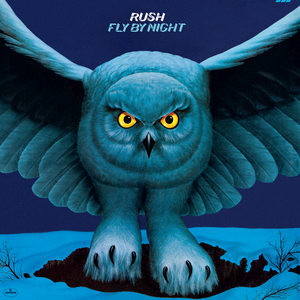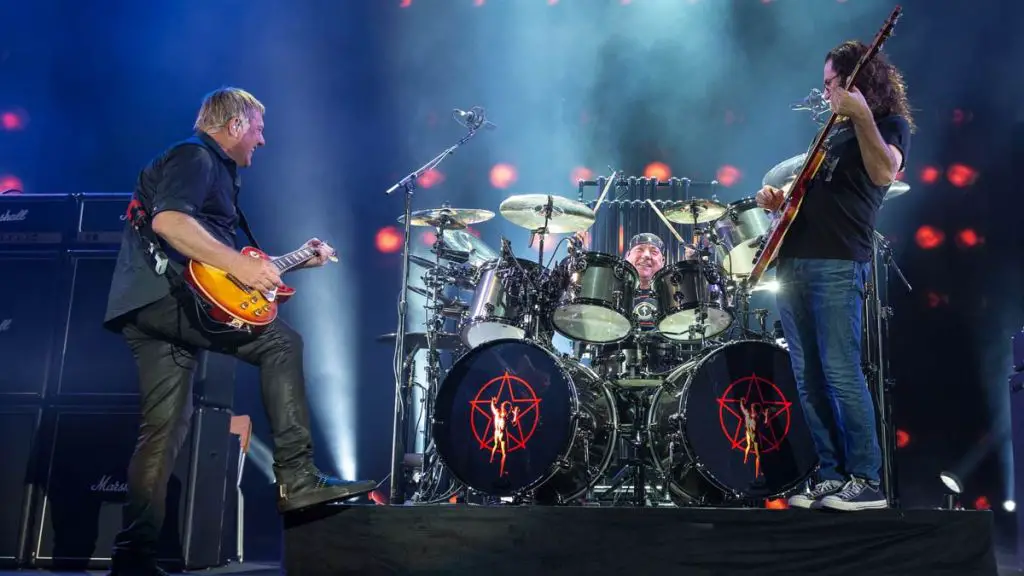All images courtesy of Getty Images/Rush Facebook (official)

By Andrew Daly
andrew@vinylwriter.com

When it comes to a band like Rush, their sound can be incredibly hard to pin down, and while most would deem Canada’s favorite sons as “Prog,” in reality, Rush is so much more than that. If you think about it, no one, let alone any Prog band, sounds like Rush.
Rush sounds like Rush.
In short — Rush created their own sound, and in doing so, launched their own genre — the Rush genre, if you will. Sure, you can take the easy way out, and lump Rush in as “Prog,” you wouldn’t be the first, but just know that in doing so, you’ll be doing yourself a disservice.
If you’re a casual fan, calling it a day, and naming Rush a mere Prog Rock band may suit you, but for those that want to dig deeper, we’ve got something on the agenda that may interest you. We’re looking beyond the lighted stage and shining the spotlight on the forgotten, the unconventional, and the non-traditional.
No, this won’t be a list for lovers of “Tom Sawyer,” “Working Man,” and “Fly By Night,” instead, we’re acting as Ghost Riders, Driven to find something deeper within the lost Temples Of Syrinx. Take a left at Lakeside Park, just past the Subdivisions, and meet us at The Fountain of Lamneth, a bit outside of Rivendell. We’re going deep into The Twilight Zone, in hopes of finding the long-lost Passage To Bangkok.
Join us for — Show Don’t Tell: Ten Overlooked Rush Deep Cuts. Let’s get started.
10)  “War Paint” from Presto (1989)
“War Paint” from Presto (1989)
By 1989, Rush had lost its way, though, perhaps not in the traditional sense. Sure, the band was still scoring hit albums, and they were fully intact as a physical unit, but from a creative standpoint, the band was fractured. The 1980s was not the golden age of power trios, no, the era was defined by five-piece Hair Metal acts with blonde-haired frontmen triumphantly screaming out-front. Rush was not that sort of band. Still, Rush could really rock, as evidenced by their 1970s and early 80s output, but somewhere along the way, the band traversed down a road of synths, and never really came back. Frustrated, Rush’s virtuoso guitar player, Alex Lifeson, was reduced to a barely-there sideman to Geddy Lee’s keyboard bonanza. Eventually, Lifeson spoke up and demanded that Rush, as a band, return to its roots as a power trio, but for the modern age. The result was Presto, which while it may not be the band’s best album, it’s still very strong, and “War Paint,” is a perfect example of Rush’s return to form. The song and the album are defined by complex, chiming guitars, bookended with precision drums, driving bass work, and cerebral lyrics. While Presto may not be Rush’s finest hour, it serves as an important moment for the band, and a harbinger for the next twenty-five or so years of the band’s recording and touring career.
9)  “Everyday Glory” from Counterparts (1993)
“Everyday Glory” from Counterparts (1993)
One could say that some of Rush’s finest work came out of the 90s, and 2000s, which would amount to the group’s final leg. What’s truly phenomenal about this era of the band is the level of musicianship the trio had achieved. As veteran players, Alex Lifeson, Geddy Lee, and Neil Peart had “leveled up,” and the material put forth via albums such as Counterparts put this on full display. After years of keyboard-drenched songs, by 1993, Rush had finally reached a comfortability with themselves, and in doing so found a perfect balance between their inherent complexity and Pop sensibilities, and for the most part, this included “simple” guitars, bass, drums, and vocals. A track like “Everyday Glory” is everything we’d come to know and love from Rush to that point, and going forward. The song has an endearing, and anthemic message, which speaks to the listener, and enables them to relate to the song. It’s here that Neil Peart’s innate ability to connect with listeners in a two-fold fashion — via the drums, and through his words — echoes through triumphantly. There’s an argument to be made that Counterparts is Rush’s best album, and “Everyday Glory,” though relatively unknown, is easily one of the album’s best tracks.
8)  “Best I Can” from Fly By Night (1975)
“Best I Can” from Fly By Night (1975)
Many non-believers view Rush as “weird,” “complex,” and “cerebral,” and while those sentiments are in some ways true, Rush, when they wanted to, could seriously rock. Case in point, after the band released its debut record, Rush, in 1974, a great many people mistook them for Led Zeppelin when “Working Man” would be broadcast over radio stations in the mid-west. Go back even further, and the band was outright rooted in late 60s Psych, and Blues Rock. While Rush may have delightfully gone off the deep end of Prog in the 70s with albums like 2112, and Hemispheres, initially, Rush were rockers, and for their 1975 album, Fly By Night, they did nothing to disparage that notion. The album is full of fantastic 70s styled bone crushers, the best of which may be the lesser-known “Best I Can,” which is a simple, three minute Rock tune that you’d expect to hear on your local Classic Rock station, except that for whatever reason — you don’t. While most people know and love tracks from Fly By Night such as “Anthem,” “By-Tor And The Snow Dog,” and “Fly By Night,” it’s “Best I Can” where Rush turns in one of its most driving, hard-rocking performances.
7)  “The Anarchist” from Clockwork Angels (2012)
“The Anarchist” from Clockwork Angels (2012)
Rush’s final album, Clockwork Angels, released in 2012, is often overlooked. It’s been said that “legacy acts” can struggle to release new music, and if they do, it’s even harder for them to gain relevance. This said, we can’t say that this was the case with Rush, as their late-career material was strong, poignant, relevant, and downright good until the end. Around the time of Clockwork Angels’ release, the band was amid several touring cycles for one milestone or another, and multiple documentaries about the band also were released, and it seems that through that all, Clockwork Angels got a bit lost. Still, the album is one of the band’s heaviest of all of its career, and was in keeping with the sound set forth starting with 1993’s Counterparts, and continued through the rest of the 90s, and into the 2000s. While Clockwork Angels, as an album, is about as heavy as Rush ever got, what it wasn’t was catchy, no, this was not an album of made-for-radio singles, which also contributed to its underrated nature. So, how do you pick the most underrated song on an album of underrated songs? Well, you dig deeper and look at certain attributes, namely lyrical content, and overall strength of songwriting, and in “The Anarchist,” we find those traits. The title of the song says it all, and the lyrics follow suit, as does the instrumentation. Alex Lifeson delivers some seriously vintage, and searingly awesome solos, and Geddy Lee’s bass work is in lockstep with Neil Peart’s tribal, yet progressive drumming. “The Anarchist” is everything you’ve come to know, and love about late-stage Rush and then some.
6)  “Earthshine” from Vapor Trails (2002)
“Earthshine” from Vapor Trails (2002)
Vapor Trails is an incredibly important album within the history of Rush as a band for many reasons. First, being released in 2002, it was Rush’s first record since 1996’s Test For Echo. The reasons for the delay were both sad, and complex. After the touring cycle for Test For Echo had ended, Rush, as a band, were riding high, and musically, were tighter than ever. Unfortunately for Neil Peart, his personal life was about to devolve into absolute, unmitigated chaos, with the sudden death of both his daughter and his wife coming in short order. The sequence of events sent Peart into seclusion and nearly marked the end of Rush as a band. After years of inactivity, and his bandmates barely hearing from him, Peart resurfaced, and ultimately decided that he would like to continue. And so, in the early 2000s, Rush reconvened in the studio to see if they had anything left in the tank after years of inactivity. The result was one of Rush’s best albums in Vapor Trails, an album filled with heavy, driving rhythms, and reflective lyrics penned during Peart’s time riding cross country on his motorcycle between 1997-2001. While the album, on the whole, is jam-packed with fantastic tracks, one of the most underrated is “Earthshine,” which features atmospheric guitar work, and vocals backed up by Peart’s ever-rumbling drums. It’s a standout moment, and certainly worth the price of admission.
5)  “Cinderella Man” from A Farewell To Kings (1977)
“Cinderella Man” from A Farewell To Kings (1977)
Rush’s reputation, fair or not, first and foremost is as the proverbial Kings of Prog, and that reputation is more or less well deserved, with many a caveat, of course. It’s within this train of thought, however, that we dig into one of Rush’s most progiest records in 1977’s A Farewell To Kings. Around this time, Rush was on a torrid pace, playing at minimum, two hundred shows a year, and more or less trapping themselves in an endless cycle of road touring and album recording. In doing so, the band, to stave off boredom, and to prove critics, and their record company wrong, chose to push themselves harder, and harder, actively choosing to play above their means, and abilities. The result was some of Rush’s most complex work, so complex that the band had immense difficulty replicating it on stage. When it comes to A Farewell To Kings, most people are familiar with the radio staple, “Closer To The Heart,” but it’s “Cinderella Man,” with its deep, observatory lyrics, and tight instrumentation that takes the cake. This track comes directly after “Closer To The Heart” in the album’s sequence, so next time you’re taking that track for a spin, listen on for an extra few minutes. You won’t be sorry you did.
4)  “Digital Man” from Signals (1982)
“Digital Man” from Signals (1982)
The 1980s was an interesting and complex time for music, and Rock music’s most interesting and complex band was no exception. Rush started off the decade with its two biggest, and perhaps most commercially viable albums in Permanent Waves, and Moving Pictures, and soon divulged its love for keyboards to the absolute max, but before that, they put out another fantastic, yet lesser loved record in Signals, in 1982. While Signals’ most well-known track is perhaps “Subdivisions,” which also served to put the world on notice that the keyboards were here, it’s “Digital Man” that serves as the album’s big winner. While some die-hard fans probably know this track, the casual or even average Rush fan often forget it exists, which is a sad thing. While there is no over the top guitar solos to be had, Alex Lifeson’s mastery is fully on display, with washes of chiming, echoing guitar bursts lushly cascading over the track from start to finish, bookended by a very tasteful solo, which serves to show Lifeson’s singular tone, phrasing, as well as his signature ability to create barometrical space. “Digital Man” is a track that is easily one of Rush’s best, and simply put — far too many people are simply unaware of its existence.
3)  “Afterimage” from Grace Under Pressure (1984)
“Afterimage” from Grace Under Pressure (1984)
Rush’s keyboard-driven era is often disparaged, and generally, it’s looked at as the band’s weakest era, and looking at it as both a fan and with a critical eye — it’s hard to disagree. Still, Rush’s mid-80s era was not without its standout moments — the band was simply too good to be held down. In the case of 1984’s Grace Under Pressure, the not-so-subtle hints that keyboards were coming laid forth on the previous year’s album, Signals, abruptly morphed into a full-blown keyboard fiesta, to varied results. Say what you will about Grace Under Pressure as an album, and the era as a whole, but “Afterimage” is a standout track, not just from Rush’s 1980s era, but from any era of the band, period. It’s been stated that the biggest issue with Rush incorporating keyboards into their sound was that they went overboard, and in doing so, they completely washed Alex Lifeson’s guitar out of the mix, but in the case of “Afterimage,” this was not the case. Deep baritone synths are in perfect lockstep with more light-textured washes, and in this case, Lifeson finds his voice throughout the track, effortlessly soloing, and riffing along with Geddy Lee’s keyboards, as opposed to fighting them. One has to wonder why Rush, as a band, or Lifeson, as a player, didn’t take this approach more often. Regardless, hindsight is 20/20, and in the case of “Afterimage,” the vision is crystal clear.
2)  “Far Cry” from Snakes & Arrows (2007)
“Far Cry” from Snakes & Arrows (2007)
Regardless of era, start to finish, Rush’s strongest selling points were the strength of the songs, coupled with next-level musicianship. Rush’s latter-era albums showcase these dynamics in ways far beyond any of their earlier works simply because the band chose to focus nearly exclusively on guitar, bass, drums, and vocals. In doing so, Rush’s musicality, and diverse songwriting pallet shined through without the assistance of keyboards, sequencers, themes, and studio trickery. Rush’s 2000s era is perhaps the finest, and most impressive of their career. Simply put, it’s a cosmically rare thing for a band nearly forty years into its career, to achieve the level of sonic sustainability that Rush was able to, more so, while penning poignant lyrics, and filling arenas across the globe. With all of this being said, when Rush dropped 2007’s Snakes & Arrows, no one could have known the level of complex emotional dissonance they would achieve with this set of guitar-driven tracks. Geddy Lee, Alex Lifeson, and Neil Peart put forth some of the finest performances of their career here, and the accompanying tour was a prime example of what made Rush, well, Rush. Still, by the casual fan, Snakes & Arrows is sadly overlooked, and as a result, one of the most beastly tracks Rush ever laid to tape, “Far Cry,” is as well. The track is aggressive, and features some interesting open acoustic riffing, before the electric instrumentation kicks in, and the album proceeds to break the listener’s balls. If you’ve forgotten about Snakes & Arrows, or perhaps dismissed the 2000s era of Rush, you’re doing yourself a disservice — it’s perhaps the most creative, and musically salient era of the band. Period.
1)  “Neurotica” from Roll The Bones (1991)
“Neurotica” from Roll The Bones (1991)
1991’s Roll The Bones not only features perhaps Rush’s coolest album cover, but it also serves as the sign marker for the band. It was the moment that the band officially became the mature version of Rush. The version that would no longer rely on concepts, synths, and overly long compositions. Roll The Bones is the album where Rush officially moved on from being the Prog band and reminded the world that they are Rock’s greatest ever power trio. So, when you think of Rush — remember that — don’t pigeonhole them as Prog only. Roll The Bones served to put the world on notice that there was to be a sonic shift in Rush’s music, and while the band would always be complex, interesting, and capable of all the things which made them Prog Rock royalty, Roll The Bones was a reminder that Rush could, and would rock. Top to bottom, Roll The Bones is loaded with memorable tracks such as “Roll The Bones,” “Dreamline,” and “Ghost Of A Chance,” but the standout track and perhaps the most underrated of the Rush’s long career is “Neurotica.” The track, like the rest of the album, features crisp, clear production values, and some tasty Alex Lifeson guitar-shredding, as well as some furious Neil Peart drum licks, and cool organ-sounding tones, which create a vibe in keeping with the songs lyrical content. As is the case with many of the tracks on this list, Rush sadly ignored this track in the live setting, which is an odd thing, as “Neurotica” serves as the perfect marriage of Rush’s Prog and Hard Rock sides. If you missed “Neurotica” over the years, double back, and dig in. The same goes for Roll The Bones on the whole. While the cover art will probably draw you in, given the chance, it’s the songs that will keep you there, and subsequently, coming back for more.
Throughout Rock history, there have been a great many bands who have come and go, some of which made an impact to some degree, but not many have the chance to grab immortality by the balls, wrench them, and run with it, but Rush did just that.
Rush’s sound is truly their own, and no one can ever duplicate it. Taking nothing away from early members, Jeff Jones, and John Rutsey, but what Alex Lifeson, Geddy Lee, and Neil Peart were able to achieve as a trio was, and still is, simply unparalleled.
Looking back, and listening to their discography of nineteen full-length albums, one EP, and countless live albums, it seems unfathomable that only three people could channel the sounds Rush did in the studio, much less in the live setting, and yet — they did.
Rush will always be a polarizing band. Likewise, Rush will always be unique. Their steadfast refusal to conform to a popular, or mainstream sound, or any particular uniform approach to recording, and making music resulted in one of the most varied, and storied careers in all of Rock music.
Rush aimed to achieve success on their terms, and their terms alone, and they did just that.
As such, their quest for experimentation bred droves of interesting tracks, some of which live on in infamy, some which are broadcast via FM radio each day, and others which for some, have yet to be discovered. If you fall into the latter category, allow this list to be your entry point into the mystical, idiosyncratic world of Rush.
Kings of Prog Rock? Maybe. The world’s great power trio? Definitely.
Either way, any way you slice it, Rush is like no other band, and if you haven’t already — take the journey. If not now — when?
What are you waiting for?
Read part 2 of this series here: https://vinylwritermusic.wordpress.com/vital-signs-ten-overlooked-rush-deep-cuts-part-ii/

– Andrew Daly (@vwmusicrocks) is the Editor-in-Chief for www.vwmusicrocks.com and may be reached at andrew@vinylwriter.com





Leave a Reply